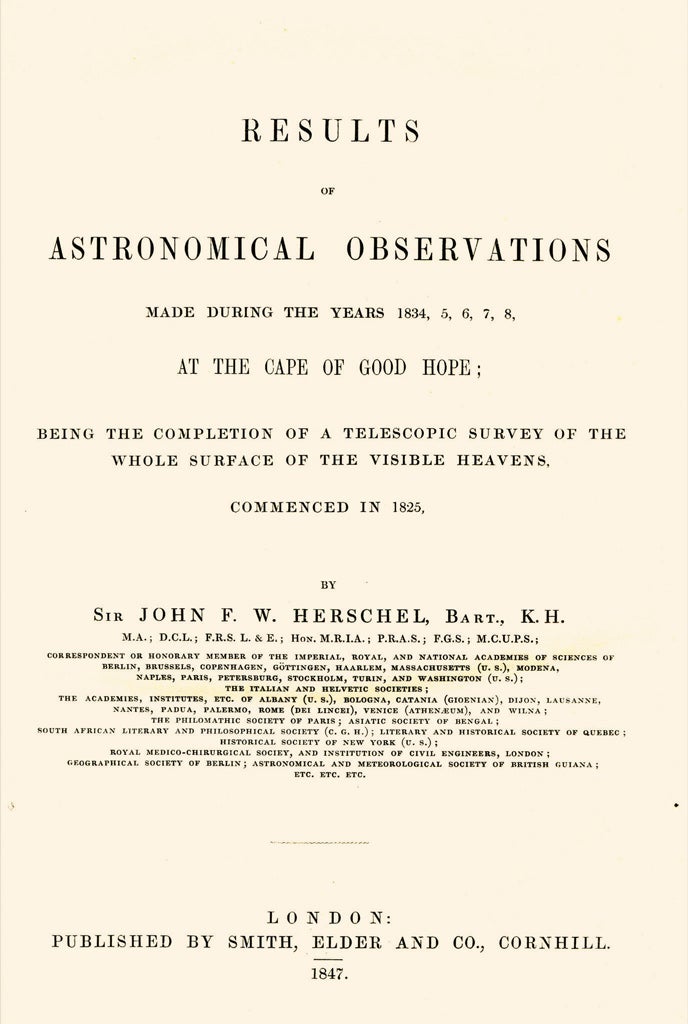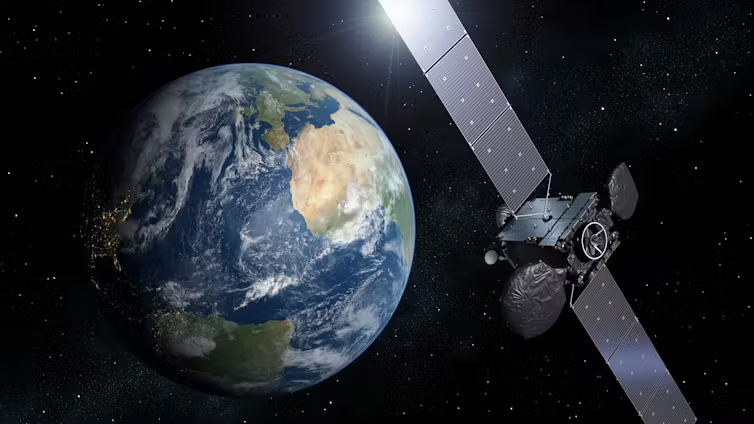family arrived from England in the Cape Colony of what is now South
Africa. His mission was to survey the southern skies like he had done
the north. Herschel kept a journal throughout his four years
there, documenting his daily activities, dinner parties, the landscape,
and, of course, his observations. What follows is a selection of his
entries.
Notice Herschel’s attention to detail when describing the landscape in
his excerpt from April 20, 1834; his excitement over Halley’s comet throughout 1835; his entries concerning his invention of
the “astrometer” in March 1836; and most notably, his description of
Eta Carina’s brightening in December 1837. Because the journal was
Herschel’s private notes, there are many abbreviations in the text. When
the entries were compiled and published as a collection, they were
preserved in their original form as close as possible.
Got the Horizontal moveable frame of the 20-feet laid down
Drew flowers & Landscapes
Walked over to Wynberg to Church, but found no Service there. Returning, examed the great granite block in Mr Hare’s grounds. It is a single stone without a flaw 16 paces long & 10 broad of an irregular oval form and rounded surface projecting about 6 feet above the soil, & nearly smooth. The granite is chiefly White Felspar in large crystals with some black mica and quartz in small quantity. Very hard & little appearance of weathering. It is accompanied by much other granite in loosely scattered masses similarly projecting & is doubtless only a projection of a great outcropping Granite Rock. Taking a course out of the Road towards the Table Hill I observed the outcrop of Granite masses (of similar nature) in several other parts so that doubtless the substratum of Wynberg Hill is Granite
After Dinner got 20-ft on the Moon but it clouded & got low so that nothing could be made of it.
NB. For a long while past the propensity to sleep after dinner has been irresistible, not a mere nap, but a long deep sleep of 1 ½ or 2 hours—shaken off with difficulty, returning unless thoroughly got rid of, and only to be conquered by decided action, and going into the open air.—
Worked at the Equatorial adjustments & got the Alt. right.— Stars dreadful owing to the conflict of the winds the NW gaining the upper hand by very slow degrees
Maclear called at Breakfast and mentioned some facts relative to astronomical matters in general.
Turned out a superb night! Such definition of Stars.—Got at last a dependable series of Meas.[ures] of γ Virginis wh is fortunate this being if I remember the day of perihelion
After a few other measures with Equatl—went to bed till the Moon set—then rose & swept over the small Magell[ani]c Cloud—then turned the Telescope on Jupiter & Mars which are in near conjunction
Swept till 4 AM—The most wonderful astronl night I ever knew—used 1200 as a good working power—saw well with 2000!
Swept till 3 am
Found in No 28 of the Phil Mag. A notice by Rumker of the Halley Comet’s place for Dec Jan Feb … April.—Set 20 feet on it. At Twilight swept for it. and then, turning the telesc. out of Merid followed & thoroughly examined the region where it is. Could find no trace of it—Afterwards went on with the Neb. in Orion with a new polished mirror (wh was also used for the Comet)
And finished with a Southern sweep.—NB This mirror is exquisite both in figure & polish.
Occupied in finishing my Equatorial working list—NB about 260 or 270 Double Stars put on the list
Cloud—no Halley’s Comet nor Stars of any kind.
Knocked up a temporary stand for the 7 feet Equatorial telescope—dismantled it & carried it out to the 1st Sand hills on the flats there erected it just at Sunset & was rewarded with the 1st glorious sight of Halley’s Comet! ! !
Worked till morning twilight at Equatorial Star Magnitudes—Comet &c. Tried a project for Comparing Stars with Moon by total refln at base of a Prism
At Home all day Prepared a prism for Star Photometer as a trial
At home all day. Rain having fallen 2 days ago and the ground being now in a favourable state for planting out bulbs I made a gardening day of it
In Evening got 1 or 2 obsns of comparative light of Stars by my Star-pole (Astrometer). Many unforeseen difficulties in the mechanical part of it but it cannot help answering—
Set a Sweep to take in Halley’s Comet.—It is fading rapidly now but nucleus is Still pretty bright
In the Evening the Moon being more than half, tried my new Astrometer with a single lens which does much better than a combination [word telescope erased] & is far simpler. Got a few Comparisons—Enough to satisfy myself that the thing will work its work.
- Got the Comet per Equatorial but it is getting very faint—
Measured a few D[ouble] Stars & went to bed
Worked at Astrometer till Moon set then went to the Equatorial & went on (being a superb night) till near daybreak—
Began a fresh map of h Argus the former being on too small a scale. Ev[enin]g Fine.—Looked for Comet but found only 2 Nebulae and one object wh at the time I felt secure was the Comet but which on coming to reduce the obsns appears to be most likely a Nebula C1 II
- Observed η Argus.
Made a Sweep.—retired at 3 am
Observed η Argus for the Map Rediscovered (decisively) the 6th (IId) Satellite of Saturn & obtained distinct proof of its being a Satellite & no star by its own & the Planets Motions
3 ¼ am. Watching a long while for a clear interval between the pouring showers at last got it superbly clear. η Argus is now hardly inferior to α Centauri, but it is inferior. Very like in colour.
It is much brighter than Rigel. Procyon is left out of all Comparison α is to n like a Ú 2m to one of 1st
1 ½ am. η Argus is not so bright as α Centauri but it far exceeds b Orionis now at nearly same Alt. It is much nearer to α Centauri than to β Orionis (Rigel). α Orionis is small and Procyon trifling compared to it
- NB α Centauri is low
As to α Crucis, β Centauri &c these are out of all question. Quite clear & Cloudless after a cloudy day & much bad cloud all night up to this time.
Fridy Night or Sat Mg 2 ½ am. η Argus is far Superior to Rigel (as it was also when all clear & of = Altitudes as an earlier hour) and decidedly exceeds α Centauri—but α is lower by far and there is also haze in sky so comparison not fair—yet I perceived no haze in or near α.—η is now evidently going on to rival Canopus.—
Sundy Morning 3 am.
Sat night, among cloud and haze so far as I could come to any conclusion by waiting for gleams & clear intervals η Argus is larger than α Centauri, and begins now to approach Canopus—There is not so much diffe betn Canopus & η as between η and α Cent.—
Pulled down the Roof of the Equatorial and dismounted & pulled to pieces the Instrument ready for packing










